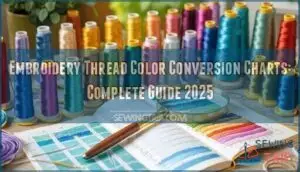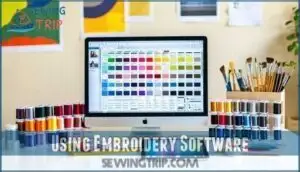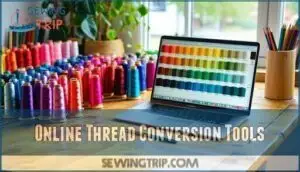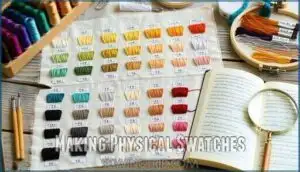This site is supported by our readers. We may earn a commission, at no cost to you, if you purchase through links.
 Embroidery thread color conversion charts are essential tools that help you match thread colors across different brands like DMC, Madeira, Anchor, and Gutermann.
Embroidery thread color conversion charts are essential tools that help you match thread colors across different brands like DMC, Madeira, Anchor, and Gutermann.
These charts solve the common headache of finding equivalent colors when your pattern calls for one brand but you’ve got another in your stash. You’ll find both digital and printed versions that show side-by-side color comparisons with corresponding thread numbers.
While conversions aren’t always perfect due to dye variations between manufacturers, these charts get you remarkably close. Most embroidery software includes built-in conversion features, and you can find free charts online or create custom ones for your specific needs, using embroidery software and thread color comparisons to achieve the desired result.
Table Of Contents
Key Takeaways
- You’ll save money and avoid project delays by using conversion charts to substitute thread brands – they let you match colors between manufacturers like DMC, Madeira, and Anchor when your pattern calls for one brand but you’ve got another in your stash.
- You can’t rely on conversion charts alone for perfect matches since dye variations exist between manufacturers – always test your color substitutions on sample fabric under proper lighting before starting your main embroidery project.
- You’ll get the most accurate conversions by combining digital tools with physical thread samples – create your own swatch book and compare actual threads under natural daylight since computer screens can’t capture every subtle color variation.
- You can create custom conversion charts using embroidery software, online tools, or physical samples to build personalized reference guides that work specifically with your thread collection and project needs.
Thread Color Conversion Basics
You’ll encounter thread color conversion when your embroidery design specifies one brand but you own a different brand of thread.
Conversion charts help you find the closest color match between thread manufacturers, ensuring your project maintains its intended appearance while using the threads you have available.
Importance of Accurate Conversions
Accurate thread color conversion forms the backbone of professional embroidery work. Without proper color matching, your projects risk looking inconsistent or amateurish.
Perfect color matches separate professional embroidery from amateur attempts—your thread choices make all the difference.
Thread color charts guarantee brand consistency across different manufacturers while delivering significant cost savings by letting you use existing thread inventory.
- Project Success depends on matching exact thread colors between different brands and avoiding costly re-work
- Avoiding Mistakes becomes easier when you verify color accuracy in embroidery before starting any project
- Cost Savings multiply when you can substitute threads confidently using reliable embroidery thread color charts
- Brand Consistency stays intact through proper thread color conversion between manufacturer specifications and available inventory
Types of Thread Conversion Charts
You’ll encounter several types of embroidery thread conversion charts designed for different needs.
Brand-Specific Charts convert between manufacturers like DMC to Anchor or Sulky to DMC. Material-Based Charts focus on polyester, rayon, or metallic threads.
Comprehensive Charts cover multiple brands simultaneously. Project-Specific Charts target quilting or machine embroidery.
Choose between Digital vs. Print formats based on your workspace preferences and conversion requirements.
Sources of Conversion Charts
You’ll find thread conversion charts from three main sources. Manufacturer charts come directly from companies like Madeira and Brother, offering official color matches for their products. Independent sources include embroidery shops and websites that create extensive conversion databases. Online databases provide interactive tools for quick lookups.
Here’s where to find reliable embroidery thread charts:
- Official manufacturer websites for brand-specific conversions
- Independent embroidery sites offering free thread charts
- Software integration tools with built-in color conversion charts.
Community contributions also expand available printable conversion charts options.
Thread Manufacturers Compared
Major embroidery thread brands offer distinct advantages for your projects.
Brand Quality varies substantially—Madeira excels in Thread Performance and durability, while Isacord provides excellent Color Matching options.
Cost Comparison shows Brother threads offer budget-friendly choices, though Availability of Brands differs by region.
Understanding each manufacturer’s strengths helps you choose the right thread brand conversion for consistent results.
Creating Conversion Charts
You can create your own conversion charts using embroidery software, online tools, or physical thread samples to match colors between different brands.
This approach gives you control over accuracy and lets you build custom charts that work with your specific thread collection and projects.
Using Embroidery Software
Embroidery software transforms thread color conversion from guesswork into precision.
You’ll create Custom Thread Charts and access Software Thread Palettes instantly.
Modern programs offer Automated Conversions between brands, making Digitizing Color Choices effortless.
Thread color matching becomes seamless when you compare options side-by-side.
| Software Feature | Popular Programs | Key Benefits |
|---|---|---|
| Thread Libraries | Hatch, Embird | Access thousands of colors |
| Custom Charts | PE-Design, Wilcom | Build personalized palettes |
| Brand Conversion | ThreadBook, SewWhat-Pro | Switch between manufacturers |
| Color Matching | Bernina Software, Brother | Visual comparison tools |
| Export Options | Most Programs | Save charts for later use |
Online Thread Conversion Tools
Online thread converters streamline your embroidery workflow with instant color matching. Tools like EmbroideryNerd.io and AllThreads.com eliminate guesswork by converting between major brands automatically.
An online thread converter can simplify this process.
These thread conversion tools offer API integration and mobile apps, though accuracy challenges exist with specialty threads requiring user reviews for verification.
| Tool | Best Feature |
|---|---|
| EmbroideryNerd.io | 36,734+ thread database |
| AllThreads.com | Robison-Anton specialization |
| ThreadArt | Custom catalog downloads |
| Madeira Exchange | Free multi-brand conversion |
Making Physical Swatches
While online conversion tools provide convenience, physical swatches deliver unmatched accuracy for thread color matching. Create your own swatch book by stitching small thread samples onto fabric strips with clear labels.
Nothing beats the precision of holding actual thread samples in your hands for true color matching.
Test your thread color accuracy under different lighting conditions. Material substrates affect how colors appear, so use fabrics similar to your actual projects. Consider dye lot variations when building your collection.
| Swatch Component | Best Practice | Why It Matters |
|---|---|---|
| Thread Length | 2-3 inches | Shows true color depth |
| Fabric Base | White cotton | Neutral background for comparison |
| Lighting Setup | Natural daylight | Reveals accurate hues |
| Organization Method | Color families | Quick visual reference |
| Durability Protection | Plastic sleeves | Prevents fading over time |
Your embroidery thread color charts become invaluable reference tools when you can physically compare swatches. A helpful tool is a complete color reference for matching needs. Swatch durability improves with proper storage away from direct sunlight. This hands-on approach beats digital color matching tools every time.
Using Conversion Charts Effectively
You’ll need to follow specific steps to get accurate results when substituting threads between different brands.
Check your conversion charts carefully and test color matches on sample fabric before starting your main project, since chart colors don’t always translate perfectly in real-world stitching.
Test color matches on sample fabric before starting your main project, since chart colors don’t always translate perfectly in real-world stitching.
Substituting Threads With Charts
Using conversion charts transforms thread swapping from guesswork into precision work.
You’ll find exact color matches between brands, saving time and frustration.
| Need | Check This | Why It’s Handy |
|---|---|---|
| Color Matching | DMC to Madeira chart | Exact shade equivalents |
| Brand Availability | Local supplier lists | Know what’s in stock |
| Project Suitability | Thread weight guides | Right thickness matters |
Chart limitations exist, but they’re your best starting point for accurate embroidery thread conversion.
Maintaining Color Consistency
Once you’ve substituted threads using charts, keeping colors consistent becomes your next challenge. Dye Lot Variance can throw off your entire project if you’re not careful. Different production runs create subtle color shifts that charts can’t predict.
Monitor Calibration plays a huge role in color accuracy. Your screen might display colors differently than they appear in real life. Set up proper Lighting Conditions using daylight bulbs or natural light when comparing threads.
Brand Color Systems vary substantially between manufacturers. What Madeira calls "red" might look orange compared to Isacord’s version. Consistent Threading means sticking with one brand per project when possible.
| Factor | Impact | Solution |
|---|---|---|
| Dye Lot Variance | Color shifts between batches | Buy enough thread upfront |
| Monitor Settings | Screen colors mislead | Calibrate display regularly |
| Lighting Type | Changes thread appearance | Use daylight bulbs |
| Brand Differences | Inconsistent color matching | Test swatches first |
| Chart Age | Outdated color references | Verify with current samples |
Trust your eyes over embroidery color charts when something looks off.
Tips for Accurate Conversions
Once you’ve mastered color consistency, accurate embroidery thread conversion requires attention to specific details that separate good matches from perfect ones.
Lighting conditions dramatically affect color perception. Compare threads under natural daylight near a window for true colors.
Brand variations and dye lots create subtle differences even within the same color number. Thread age can fade colors over time.
| Factor | Solution |
|---|---|
| Poor lighting | Use daylight bulbs |
| Faded threads | Replace old stock |
| Brand differences | Test stitching samples |
Color conversion charts work best when you verify matches with actual thread color conversion testing.
Advanced Conversion Techniques
You’ll encounter complex conversion challenges when working with specialty threads like metallics, variegated colors, and custom brand combinations that require advanced techniques beyond standard charts.
These methods include using embroidery software for precise color matching, creating custom conversion databases, and implementing professional color management systems to handle gradient shifts and thread-specific properties.
Converting to Specific Thread Brands
Brand-specific conversions require understanding each manufacturer’s unique strengths. Brand Performance Differences matter when switching from Madeira’s smooth finish to Isacord’s durability-focused polyester.
Budget Thread Conversion becomes straightforward with charts showing affordable alternatives to premium brands. Check Preferred Brand Availability at your local shop before committing to a conversion chart.
Brand Color Accuracy varies substantially—Brother’s vibrant blues won’t match Sulky’s muted tones exactly. Project-Specific Conversions work best when you match thread characteristics to your fabric weight and design complexity.
Managing Color Gradients and Special Threads
Color gradients and special threads require targeted strategies beyond standard embroidery thread color conversion methods. Gradient Blending starts with selecting colors that share similar undertones – cool blues flow better into purples than warm oranges.
For Metallic Management, use size 14/90 needles and reduce machine speed by 30%. Variegated Challenges emerge when thread colors shift unpredictably, so test small sections first.
Specialty Substitutions work best when you match thread weights alongside colors.
- Feel the satisfaction of seamless color shifts that make viewers stop and stare
- Experience the confidence of handling tricky metallic threads without constant breaks
- Discover the joy of creating custom color conversion charts for unique effects
- Embrace the excitement of mastering techniques that separate amateur from professional work
Implementing Color Management in Embroidery Software
Modern embroidery software transforms thread color conversion challenges into streamlined workflows.
Configure Software Color Profiles to match your machine’s specifications, then activate Gamut Mapping Options for accurate brand-to-brand conversions.
Use built-in Color Calibration Tools to fine-tune hue matching across different thread manufacturers.
Create Custom Palette Creation libraries by importing Brand Color Libraries from major suppliers.
See options for managing these profiles for different software.
Your software becomes a powerful color conversion for embroidery hub, automatically suggesting closest matches while maintaining thread color charts for future reference.
Frequently Asked Questions (FAQs)
What are thread conversion charts for machine embroidery?
Like translating between languages, thread conversion charts act as your bridge between different embroidery thread brands.
They help you find matching colors when you can’t use the exact brand specified in patterns, which is a crucial function for embroidery purposes.
What is embroidery thread conversion?
Embroidery thread conversion lets you substitute one thread brand for another by matching colors.
You’ll use conversion charts to find the closest color equivalent when your pattern specifies a different brand than what you own.
How do I use a thread conversion chart?
Find your design’s thread brand and color number, then locate the corresponding row in the conversion chart.
Match it to your preferred brand’s column to find the closest color equivalent for your project.
What is a thread brand conversion chart?
Thread brand conversion charts match colors between different manufacturers like Madeira, Isacord, and Brother.
You’ll use them when your pattern calls for one brand but you’ve got another thread type in your stash, which can be particularly useful in situations where thread availability is limited.
What are thread color conversion charts?
Color conversion charts serve as your diplomatic bridge between thread brands, helping you diplomatically substitute one manufacturer’s shade for another’s closest equivalent.
You’ll find these invaluable when your preferred brand doesn’t match your pattern’s specifications, which can be a common issue, and having a diplomatic solution is key.
How do I use thread charts for embroidery?
Start by matching your design’s thread numbers to the chart’s left column.
Find the corresponding color in your preferred brand’s column.
Cross-reference carefully since colors won’t match perfectly.
Always test-stitch sample colors first to ensure accuracy, and remember to cross-reference carefully.
What color is 399 embroidery thread?
Like searching through a telegraph operator’s color codebook, you’ll need to specify which brand uses number
Different manufacturers assign unique numbers to colors, so 399 varies between Madeira, Isacord, or Brother threads.
What color is 333 embroidery thread?
You’ll find that 333 embroidery thread typically represents a medium purple or violet shade, though the exact color varies between manufacturers like DMC, Madeira, and Brother.
Always check your specific brand’s color card for accuracy.
What color is 310 embroidery thread?
Telegraph operators would recognize 310 as deep black – the darkest shade you’ll encounter.
This DMC thread number represents true black, perfect for outlining, text, or creating dramatic contrast in your embroidery projects.
What color is 707 embroidery thread?
Thread 707 varies by brand, but you’ll typically find it’s a vibrant orange or coral shade. DMC 707 is a bright orange, while other manufacturers might lean toward coral-orange tones.
Conclusion
Mastering embroidery thread color conversion charts transforms your stitching experience from frustrating guesswork to confident creativity.
You’ll discover that the most accurate conversions come from combining digital tools with physical thread samples, since computer screens can’t capture every subtle color variation.
These charts save money by letting you use existing thread stash while maintaining project quality, whether you’re working with DMC, Anchor, or specialty threads.
Reliable embroidery thread color conversion charts guarantee your finished pieces match your creative vision perfectly, ensuring that your stitching experience is both enjoyable and fulfilling.
- https://www.rnkdistributing.com/resources/thread/ThreadConversionChart.pdf
- https://www.brother-usa.com/Virdata/SAPHTMLEditorFiles/5329756EC43812B7E1000000CD8620B8.PDF?_ga=2.147447539.515730047.1660186645-997647510.1658344585&_gl=1*1ao5nq8*_ga*OTk3NjQ3NTEwLjE2NTgzNDQ1ODU.*_ga_NCEW43SJ8W*MTY2MDE4NjY0Ni41LjAuMTY2MDE4NjY0Ni42MA..
- https://help.brother-usa.com/app/answers/detail/a_id/75245/~/thread-color-conversion-chart
- https://embroideryonline.com/content/projecthub/e101/PDFs/madeira-polyneon-to-isacord-conversion-chart.pdf











